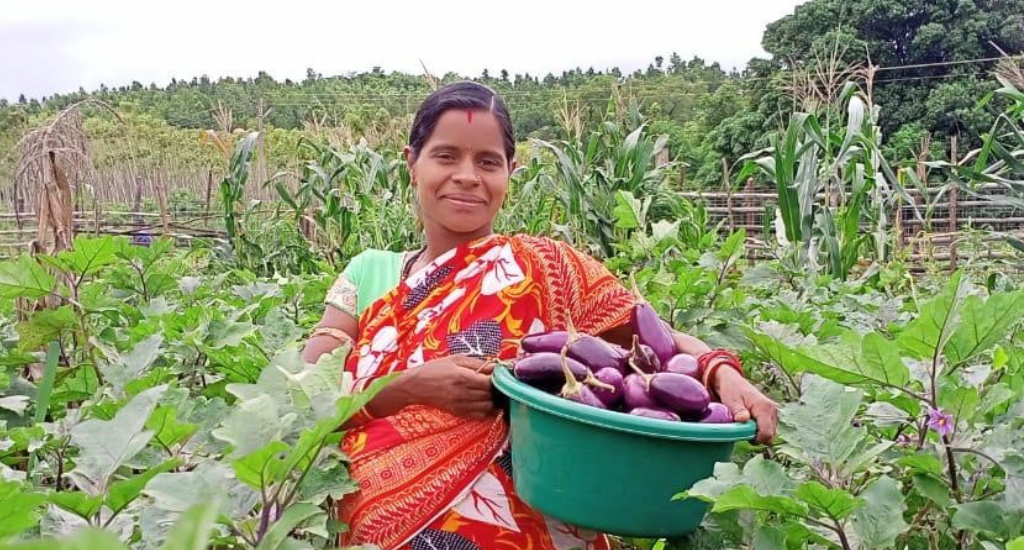Balmati Goud, a tribal woman, worked on her small agricultural land (2 acres) with her husband in Kalahandi, Odisha. Used to traditional farming methods, she was unaware of advanced and sustainable farming practices.
Balmati and her husband cultivated mainly rain-fed crops like millet, pulses, paddy and seasonal vegetables.
Despite all the blood, sweat and tears, their income did not increase. Often, the produce was not enough even for their own household consumption.
This pushed her to work as a daily wage labourer in addition to cultivating her land. But even this was proving to be insufficient. She was starting to lose hope.
But then came the turning point.
The turning point
While attending a farmers’ meeting organized by the Harsha Trust, Balmati was introduced to the ‘50-cent model.’
Here she received intensive training and capacity-building inputs towards adopting advanced farming practices.
She learned new farming practices, such as the cultivation of selective vegetables, raised beds, trellis and pipe-based irrigation. During the meeting, she became familiar with the 50-cent model, which focuses on making the most out of small pieces of land.
This turned out to be a watershed moment.
What is the 50-cent model?
The 50-cent model aims to maximize productive capacity of small pieces of land, leading to higher remuneration for the farmers. It focuses on employing advanced agricultural practices and technology.
‘Package of practices’ is an integral part of the 50-cent method. It includes raised bed farming, appropriate water management practices, installation of trellises for weak plants, timely weeding and using organic fertilizers.
Novel and advanced irrigation systems such as piped irrigation is also introduced within this model. In addition, emphasis is placed on crop planning. The 50-cent model encourages farmers to use commercially large scale crops that take less effort to grow.

Farmers are encouraged to see technology as a friend, not foe. Adopting new technologies can reduce the amount of physical labour and maximize productivity from the limited land.
Also, for places like Rampur tehsil where Balmati resides, farmers are nudged towards wired fencing to protect their crops from elephants and wild boar.
Balmati’s journey on the 50-cent road
Balmati adopted the ‘package of practices’ for better crop production and cultivated commercial vegetables such as cauliflower (10 cents), brinjal (20 cents), cabbage (10 cents) and beans (10 cents).
She began to use new technology made available under the 50-cent model while also safeguarding her crops with wired fences. Her use of pipe-based irrigation also ensured the health of her crops all year.
Balmati reported a significant increase in income as a result.
In 2021-22 she generated a gross income of Rs. 84,500 and a net income of Rs. 69,050 using the model. But because she did not have exact earning figures for previous years, calculating the actual income difference between traditional farming and the 50-cents model was difficult.
The reduced physical labor was a huge plus too.
Most importantly, Balmati achieved self-sufficiency through her consistent efforts. Her family’s nutritional needs were also better met as a result of the organic vegetables grown on her land.
Lessons from Balmati’s experience
Like most of the other tribal farmers, she was unfamiliar with the 50-cent model at first. There was hesitation to let go of traditional methods that she inherited from her ancestors.
Balmati took a long time to accept these advanced farming methods. However, she overcame these obstacles, thanks to her consistent efforts.
Because of its small size, the local market (in Rampur) may not be able to support all of the farmers cultivating with the 50-cent model. As a result, more marketing channels will need to be established in order for more farmers to see this model as profitable.
Many tribal women, like Balamati, can achieve self-sufficiency and higher income with the right skills and training. Her success demonstrates that by training rural farmers in advanced farming practices, farming can become significantly more profitable.
The lead image at the top shows Balmati Goud cultivating commercial vegetables such as cauliflower, brinjal, cabbage and beans (Photo by Sangeeta Behera)
Sangeeta Behera is a Communications Executive at Harsha Trust.







